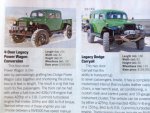You are using an out of date browser. It may not display this or other websites correctly.
You should upgrade or use an alternative browser.
You should upgrade or use an alternative browser.
most capable off-road pickup?
- Thread starter ssssnake529
- Start date
Mountainhound
Explorer
Love to buy a new truck for that money:wings:
I think you could call these factory...
Modern running gear, classic lines such attainable price's.
View attachment 183372
RangeBrover
Explorer
Love to buy a new truck for that money:wings:
Pretty much is a new truck.
Love to buy a new truck for that money:wings:
You could buy 4 new trucks for that money. They look very cool but for that money I think I'd buy a new Power Wagon, a Jeep and a Corvette.
http://www.legacypowerwagon.com/Legacy-Dodge-Carryall_p_14.html
Clutch
<---Pass
You could buy 4 new trucks for that money. They look very cool but for that money I think I'd buy a new Power Wagon, a Jeep and a Corvette.
http://www.legacypowerwagon.com/Legacy-Dodge-Carryall_p_14.html
Shoot for that kind of money, I could buy damn near every flavor of KTM enduro.
http://www.ktm.com/us/enduro.html
Mountainhound
Explorer
My bad missed the comma thought it was a old ad.
Not currently being made, but the Comanche with a 44 rear was a great little truck. It's narrow platform and xj front suspension make it easy to lift and very capable. Those full size trucks are great for power and hauling the whole family, but when is the last time you seen on on a real trail?
Clutch
<---Pass
Yeah, that's what I was afraid of. Rectangle peg, meet square hole. The weird thing is, the B series ended up in Dodges because it was cheap and readily available. But the new engine seems purpose built for the truck. I haven't seen them in a single piece of heavy equipment anywhere. Should have made a V8 or Slant 6.
-
The 6.7 cummins is used many heavy machinery applications, a few that i know of are Sennebogen 835, Komatsu PC228, and Sierra Car crusher/bailer, i know there are plenty of other variants and other brands that use these motors, but i doubt you searched too long if you think that the 6BT is not a heavily used motor in non-dodge applications. Screw the V8, inline 6 is strongest.
Buliwyf
Viking with a Hammer
No kidding, the B is in heavy equipment. That's were it came from and why it was a cheap choice at the time.
-
Read it again. I was talking about the new 6.7L that replaced the B. No idea why they stuck with an I6 that hardly fits, when that engine appears to be purpose built just for the new trucks. I haven't seen the NEW engine in anything other than a Dodge. A V just seems like it would fit better. There's nothing about the shape of an I that makes it stronger. V's can be designed the same way. Most BIG diesels are V's.
-
Read it again. I was talking about the new 6.7L that replaced the B. No idea why they stuck with an I6 that hardly fits, when that engine appears to be purpose built just for the new trucks. I haven't seen the NEW engine in anything other than a Dodge. A V just seems like it would fit better. There's nothing about the shape of an I that makes it stronger. V's can be designed the same way. Most BIG diesels are V's.
RangeBrover
Explorer
Inline engines are actually inherently stronger, they require fewer cylinder heads, camshafts, and they also have a support bearing between each piston.
Buliwyf
Viking with a Hammer
Inline engines are actually inherently stronger, they require fewer cylinder heads, camshafts, and they also have a support bearing between each piston.
I think you made my point for me. None of that has really been, or ever should be a problem any more than a typical I. Any 2 V heads or cams are no more or less likely to fail than their single I counterpart. And modern deep skirt blocks with side bolts take care of the bearing bit.
Last edited:
Kaisen
Explorer
Inline engines are actually inherently stronger, they require fewer cylinder heads, camshafts, and they also have a support bearing between each piston.
Fewer parts, yes. Stronger, no way. The differences between an inline 6 and a V6 (or V8) are simply compromises. One long head is weaker and more likely to twist/warp/lift than two short heads. One long skinny block is weaker than a short compact block. The firing order of a I6 is inherently smoother. Packaging and weight distribution favors the V layout. Weight and size per displacement favors the V layout.
Duramax has ONE cam....how is that more than a I6 Cummins?
Duramax has five cross-bolted splayed main caps (20 bolts), I6 Cummins has seven two-bolt main caps (14 bolts)
NorthernWoodsman
Adventurer/tinkerer
Admittedly knowing very little about diesels, I do have to wonder why most large ship diesels are inline motors, not V configuration...if the V is indeed a superior design...? Almost all, if not all, large ship motors are of the inline design. And these are the most powerful motors on earth. Or ocean rather.
These motors reach 1.5 million cubic inches with power output at 108,000+ HP. The motors typically come in 8, 10, 11, 12, 14, 16, and 18 cylinder versions.
These motors reach 1.5 million cubic inches with power output at 108,000+ HP. The motors typically come in 8, 10, 11, 12, 14, 16, and 18 cylinder versions.


